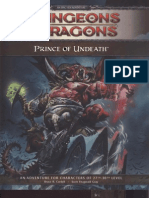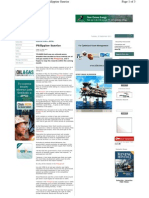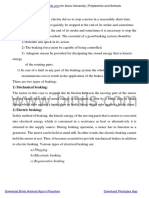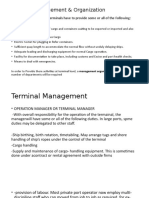0 ratings0% found this document useful (0 votes)
82 viewsPal
Pal
Uploaded by
Princesz MoldezLucio Tan surprised the market in 2012 by selling 49% of Philippine Airlines (PAL) to San Miguel Corporation, led by Ramon Ang. However, in 2014 Tan announced he was taking back control of PAL. PAL had faced financial difficulties since the Asian financial crisis in the late 1990s due to high debt and unprofitable routes. San Miguel's investment helped PAL embark on a large aircraft refleeting program and restructure operations. However, the partnership between Tan and Ang became strained due to disagreements over management. Tan regained full control of PAL in 2014 reportedly due to Ang not following through on promises to buy the remaining PAL stake and other issues that arose in their business relationship.
Copyright:
© All Rights Reserved
Available Formats
Download as DOCX, PDF, TXT or read online from Scribd
Pal
Pal
Uploaded by
Princesz Moldez0 ratings0% found this document useful (0 votes)
82 views2 pagesLucio Tan surprised the market in 2012 by selling 49% of Philippine Airlines (PAL) to San Miguel Corporation, led by Ramon Ang. However, in 2014 Tan announced he was taking back control of PAL. PAL had faced financial difficulties since the Asian financial crisis in the late 1990s due to high debt and unprofitable routes. San Miguel's investment helped PAL embark on a large aircraft refleeting program and restructure operations. However, the partnership between Tan and Ang became strained due to disagreements over management. Tan regained full control of PAL in 2014 reportedly due to Ang not following through on promises to buy the remaining PAL stake and other issues that arose in their business relationship.
Original Description:
Reaction paper
Copyright
© © All Rights Reserved
Available Formats
DOCX, PDF, TXT or read online from Scribd
Share this document
Did you find this document useful?
Is this content inappropriate?
Lucio Tan surprised the market in 2012 by selling 49% of Philippine Airlines (PAL) to San Miguel Corporation, led by Ramon Ang. However, in 2014 Tan announced he was taking back control of PAL. PAL had faced financial difficulties since the Asian financial crisis in the late 1990s due to high debt and unprofitable routes. San Miguel's investment helped PAL embark on a large aircraft refleeting program and restructure operations. However, the partnership between Tan and Ang became strained due to disagreements over management. Tan regained full control of PAL in 2014 reportedly due to Ang not following through on promises to buy the remaining PAL stake and other issues that arose in their business relationship.
Copyright:
© All Rights Reserved
Available Formats
Download as DOCX, PDF, TXT or read online from Scribd
Download as docx, pdf, or txt
0 ratings0% found this document useful (0 votes)
82 views2 pagesPal
Pal
Uploaded by
Princesz MoldezLucio Tan surprised the market in 2012 by selling 49% of Philippine Airlines (PAL) to San Miguel Corporation, led by Ramon Ang. However, in 2014 Tan announced he was taking back control of PAL. PAL had faced financial difficulties since the Asian financial crisis in the late 1990s due to high debt and unprofitable routes. San Miguel's investment helped PAL embark on a large aircraft refleeting program and restructure operations. However, the partnership between Tan and Ang became strained due to disagreements over management. Tan regained full control of PAL in 2014 reportedly due to Ang not following through on promises to buy the remaining PAL stake and other issues that arose in their business relationship.
Copyright:
© All Rights Reserved
Available Formats
Download as DOCX, PDF, TXT or read online from Scribd
Download as docx, pdf, or txt
You are on page 1of 2
MOLDEZ, Princess M.
BSA A3A
August 10, 2015
Strategic Management
Transfer or Sale of Philippines Airlines (PAL) from Lucio Tan to San
Miguel Corp. and from SMC back to Lucio Tan
In the year 2012, tycoon Lucio Tan surprised the market when it forged a deal to
sell nearly half its stake in legacy carrier Philippine Airlines (PAL) to an unlikely partner:
his arch rival in the beer industry, San Miguel Corporation. The 2012 agreement gave
San Miguel 49% of PAL for $500 million, and led by its top honcho Ramon Ang, also
took control of the airline management. The Tan group planned to leave the business by
selling the rest of its PAL stake to San Miguel, which, in turn, expressed intention to
acquire full ownership. Fast forward to 2014, the market was again surprised. Tan
announced he was taking back the stake it sold San Miguel to again become PALs
Kapitan, as he is fondly called.
PAL woes
The 80-year-old Tan took control of PAL from the government in 1995. It was the first
venture of the tobacco and beer entrepreneur into non-allied interests. In 1997, PAL
went on aggressive expansion, but an expensive refleeting program, along with
unprofitable routes, made it financially unstable. That year, Asia went through a financial
crisis, and PAL was badly hit as its debts ballooned. PAL undertook massive layoffs,
resulting in disputes with its worker union that forced it to shut down for a brief period in
1998. The disputes were settling, PAL underwent rehabilitation, and, by 2000, returned
to profitability. In 2008, the US Federal Aviation Administration downgraded the
Philippines aviation status to Category 2 from Category 1 due to non-compliance with
global safety standards. The downgrade prevented PAL from expanding operations in
the US. The downgrade would later on prompt the European Union (EU) to also ban
Philippine carriers from entering its airspace. While this happened, PAL was feeling the
brunt of soaring fuel prices and declining passenger demand amid tight local
competition. PAL was posting millions of dollars in losses.
San Miguels entry
San Miguels entry was a breath of fresh air. Bleeding from its woes, PAL, Asias first
airline, would benefit a lot from a new investor with funds, which it needed to survive the
industry. PAL embarked on a $9.5-billion refleeting program. It restructured operations
by using smaller but cost-efficient aircraft for short, domestic routes, and reserved the
wide-bodied aircraft for long-haul destinations such as the US and Europe. The
refleeting program called for the purchase of 100 new aircraft and retirement of aging
ones in a bid to become one of Asias youngest fleet at 3.5 years. Luck was also on
PALs side when, in 2013, the EU lifted its ban on the carrier and the US aviation
authorities followed suit this year, upgrading the Philippines status back to Category 1.
By the second quarter of 2014, PAL was back in black. The prospects of new services
to lucrative long-haul markets were all a possibility. Investing in PAL wasnt a bad idea
after all.
Why buy it back?
The promising developments as of late could be considered reason for Tan to
take PAL back. But analysts maintained the nature of the business remains the same: it
is risky, capital-intensive, and will continue to battle rising jet fuel prices and increasing
competition. It was an emotional decision for Tan, said the source. A column by The
Philippine Stars Boo Chanco also earlier suggested that Tan wanted to regain the
prestige he used to enjoy when he was head of PAL. His ego was preventing him from
making a decision thats purely business. The decision could be considered a
business one only for the reason that Ang kept delaying his promise to buy back the
rest of Tans stake.And with growing problems in their marriage, amid reported
disagreements over management, it was best to just take it all back. Reports had it that
the partnership had been shaky. Some members of the Tan camp were not at all happy
when San Miguel came in, much more when it started taking business away from PAL
affiliates. Tan was also reportedly not happy with the generous early retirement option
that Ang-led management offered PAL employees. Other issues involved a fuel supply
with San Miguels Petron Corporation and that Ang was collecting commissions from the
refleeting, an allegation Ang supposedly belied by presenting documents from aircraft
suppliers. In a party to celebrate the buyback on the night of September 15, Tan said:
PAL is more than an airline company for me. It goes beyond investing it is like family.
PAL is never far from my thoughts. In a disclosure to the Philippine Stock Exchange on
September 16, San Miguel said Tan assumed day-to-day management of PAL through
the appointment of its former president, Jaime Bautista, as general manager. But it
maintained that Ang, as president of PAL, remains, along with the rest of his team, "until
the relevant closing date of the agreement" between the parties.
You might also like
- Philippine Airlines Marketing Plan: Submitted To: Sir Edwin AgujetasDocument10 pagesPhilippine Airlines Marketing Plan: Submitted To: Sir Edwin AgujetasLester Mojado100% (2)
- LVL 27 Prince of UndeathDocument98 pagesLVL 27 Prince of UndeathArturo Partida93% (15)
- Operations Strategy - Philippine AirlinesDocument30 pagesOperations Strategy - Philippine AirlinesAngel Locsin100% (1)
- BBMD005 Group 2 Pestle Analysis-1Document5 pagesBBMD005 Group 2 Pestle Analysis-1ririNo ratings yet
- Philippine AirlinesDocument6 pagesPhilippine AirlineschenlyNo ratings yet
- Pia Case StudyDocument3 pagesPia Case Studyvinaychughani100% (1)
- R4.2 Case-Peng Plasma SolutionsDocument11 pagesR4.2 Case-Peng Plasma SolutionsDanielle WalkerNo ratings yet
- Final ProjectDocument47 pagesFinal ProjectKathlyn Kaye SanchezNo ratings yet
- Hanjin Philippines DilemmaDocument2 pagesHanjin Philippines DilemmabcayapanNo ratings yet
- AHM39 Changes 20181029Document3 pagesAHM39 Changes 20181029jakchan0% (1)
- Honeymoon and DivorceDocument6 pagesHoneymoon and DivorcePatricia Bianca ArceoNo ratings yet
- Study On The Reprivatization of Philippine AirlinesDocument15 pagesStudy On The Reprivatization of Philippine AirlineswestphaliaNo ratings yet
- Study On The Reprivatization of Philippine AirlinesDocument15 pagesStudy On The Reprivatization of Philippine AirlinesMiX QuENo ratings yet
- Strategic Business Analysis Assignment 1Document4 pagesStrategic Business Analysis Assignment 1PewdsNo ratings yet
- Casestudy Grou5Document13 pagesCasestudy Grou5Zairalyne GonzalesNo ratings yet
- Compensating Human Resources in PALDocument3 pagesCompensating Human Resources in PALDiana Ross Riingen Salacup100% (1)
- Philippine AirlinesDocument4 pagesPhilippine AirlineschenlyNo ratings yet
- PAL To Trim Costs With New Planes in 2014Document5 pagesPAL To Trim Costs With New Planes in 2014Michael Leo Dela CruzNo ratings yet
- Philippine Airline's Financial Decline in The Aftermath of Airline DeregulationDocument14 pagesPhilippine Airline's Financial Decline in The Aftermath of Airline DeregulationShear WindNo ratings yet
- The Airline Industry in The PhilippinesDocument32 pagesThe Airline Industry in The PhilippinesZịtNo ratings yet
- APEC Reaction PaperDocument1 pageAPEC Reaction PaperAlyanna CabralNo ratings yet
- PAL Debtor SourcesDocument11 pagesPAL Debtor SourcesZarah Jill ProbadoraNo ratings yet
- Lima Lightning: Pushing Back: Inside This IssueDocument12 pagesLima Lightning: Pushing Back: Inside This IssueskyshiftsNo ratings yet
- MangoDocument4 pagesMangoMLR123No ratings yet
- History of Philippine AirlinesDocument4 pagesHistory of Philippine AirlinesJenica Caber100% (1)
- CASE 1 - Philippine AirlinesDocument6 pagesCASE 1 - Philippine AirlinesmarietorianoNo ratings yet
- Case Study PIADocument5 pagesCase Study PIAMystiquemashalNo ratings yet
- Parmalat ScandalDocument10 pagesParmalat ScandalNisseem KrishnaNo ratings yet
- Case Study Reinventing San Miguel CorporationDocument3 pagesCase Study Reinventing San Miguel Corporationkristoffer_sayarot100% (1)
- Narrative ReportDocument14 pagesNarrative Reportfebe mae barteNo ratings yet
- Group7 Act1-FDocument3 pagesGroup7 Act1-FElnel TolibasNo ratings yet
- Lucrative Airport Project Is Quickly Mired in Dispute and Dubious ActivityDocument4 pagesLucrative Airport Project Is Quickly Mired in Dispute and Dubious ActivityJan neNo ratings yet
- History of Philippine AirlinesDocument4 pagesHistory of Philippine AirlinesRynjeff Lui-PioNo ratings yet
- Case Study PIADocument6 pagesCase Study PIAZeeShan Naseem100% (1)
- Airline Industry in The Philippines: Michelle Rizza M.MoraDocument29 pagesAirline Industry in The Philippines: Michelle Rizza M.MoraMichelle MoraNo ratings yet
- Philippine Airlines DocumentDocument2 pagesPhilippine Airlines DocumentEmmanuel AbrahamNo ratings yet
- 08 Quiz 1 - ARGDocument1 page08 Quiz 1 - ARGAlvarez Jaf100% (1)
- Case StudyDocument2 pagesCase StudyHerondaleNo ratings yet
- Case Study PIADocument6 pagesCase Study PIARehan MansoorNo ratings yet
- PALDocument35 pagesPALJohn Paul MillezaNo ratings yet
- 11 05 19 - Media Release - Petron Reports P3.6 Billion Net Income in First Nine Months.Document3 pages11 05 19 - Media Release - Petron Reports P3.6 Billion Net Income in First Nine Months.Jonathan ChoiNo ratings yet
- 08 Quiz TranspoDocument1 page08 Quiz TranspoDanica Jane ErandioNo ratings yet
- IMC Plan-Airphil ExpressDocument38 pagesIMC Plan-Airphil ExpressAndrea Salazar LunaNo ratings yet
- SR45 PhilippinesDocument23 pagesSR45 PhilippinesTeresita MaralitNo ratings yet
- Return On Assets For The 12 Months Ending June 30th For Each YearDocument5 pagesReturn On Assets For The 12 Months Ending June 30th For Each Yearshahwal92No ratings yet
- Asssesment 2Document4 pagesAsssesment 2alexandraburgos880No ratings yet
- AftermathDocument2 pagesAftermathClaraMarcellaNo ratings yet
- Airline Bankruptcy Stories: February 2017Document6 pagesAirline Bankruptcy Stories: February 2017Fabricio FrançaNo ratings yet
- Assessing The Chapter 11 Filed Bankruptcy of Philippine Airlines in This Covid19 Crisis PDFDocument11 pagesAssessing The Chapter 11 Filed Bankruptcy of Philippine Airlines in This Covid19 Crisis PDFfanchasticommsNo ratings yet
- At&t 2 TW 3-1-14Document1 pageAt&t 2 TW 3-1-14Price LangNo ratings yet
- Case Study 2Document1 pageCase Study 2shin_chan50No ratings yet
- Task Performance State of Local AirlinesDocument7 pagesTask Performance State of Local Airlinesrency quilantangNo ratings yet
- DocxDocument48 pagesDocxjikee1150% (2)
- Petron: Oversubscription in P10B Preferred SharesDocument3 pagesPetron: Oversubscription in P10B Preferred SharesBusinessWorldNo ratings yet
- Fearnley 1 FOSAS Summary Report 2018Document44 pagesFearnley 1 FOSAS Summary Report 2018Charles GohNo ratings yet
- Air Canada CaseDocument34 pagesAir Canada Casevarsaxena0% (1)
- Name: Faiq Khalid Registration No: 46006 Subject: Strategic ManagementDocument4 pagesName: Faiq Khalid Registration No: 46006 Subject: Strategic ManagementFAIQ KHALIDNo ratings yet
- Delta Airlines Case StudyDocument4 pagesDelta Airlines Case Studynrmpz9b54dNo ratings yet
- Singapore AirlinesDocument13 pagesSingapore AirlinesRoman ZeißNo ratings yet
- Philippine Sunrise: South East AsiaDocument3 pagesPhilippine Sunrise: South East AsiaJames McGrathNo ratings yet
- Balearia v. Calvo SentenciaDocument22 pagesBalearia v. Calvo SentenciaICNoticiasNo ratings yet
- Flying High: How JetBlue Founder and CEO David Neeleman Beats the Competition... Even in the World's Most Turbulent IndustryFrom EverandFlying High: How JetBlue Founder and CEO David Neeleman Beats the Competition... Even in the World's Most Turbulent IndustryRating: 3.5 out of 5 stars3.5/5 (7)
- Routes in Central and South Bristol Walk 2 - Sculpture TrailDocument11 pagesRoutes in Central and South Bristol Walk 2 - Sculpture TrailBogdanBNo ratings yet
- SAP MRP DetailDocument45 pagesSAP MRP Detailvijay prabhu100% (1)
- Surespan Power Capability Rev 1nov13Document18 pagesSurespan Power Capability Rev 1nov13Nathsgel GelitoNo ratings yet
- 2024 LC SetsDocument8 pages2024 LC Setsapi-614526867No ratings yet
- Definition of Mixed Use DevelopmentDocument34 pagesDefinition of Mixed Use DevelopmentAnwar Mohammed100% (1)
- The War in The Pacific Coast of South America 1879 - 81Document83 pagesThe War in The Pacific Coast of South America 1879 - 81BibliomaniachilenaNo ratings yet
- Ship Structural Details PDFDocument329 pagesShip Structural Details PDFzeek77No ratings yet
- Integrail: (Intelligent Integration of Railway Systems) EU Co-Funded R&D ProjectDocument2 pagesIntegrail: (Intelligent Integration of Railway Systems) EU Co-Funded R&D ProjectCuter HsuNo ratings yet
- Chapter Thirteen Design of Traffic Signals: 13-1 Interrupted FlowDocument30 pagesChapter Thirteen Design of Traffic Signals: 13-1 Interrupted FlowAhmedMahirNo ratings yet
- Retrovisor 2017Document4 pagesRetrovisor 2017Comp AutoNo ratings yet
- List of Library Books - Narotam Morarji UniversityDocument116 pagesList of Library Books - Narotam Morarji Universityshital_vyas1987No ratings yet
- Product Recommendation Lamborghini Murciélago Murciélago (2002-2006)Document3 pagesProduct Recommendation Lamborghini Murciélago Murciélago (2002-2006)miguel sousaNo ratings yet
- Construction Equipments - Rollers: Presented byDocument16 pagesConstruction Equipments - Rollers: Presented byAditi BazajNo ratings yet
- HKU GEOG2144 Examination Questions (2022-23)Document2 pagesHKU GEOG2144 Examination Questions (2022-23)chiunokhim2002No ratings yet
- Devi Shakuntala - Puzzles To Puzzle You-Orient Paperbacks (2005)Document136 pagesDevi Shakuntala - Puzzles To Puzzle You-Orient Paperbacks (2005)smaliasNo ratings yet
- EE8015 UNIT 4 TractionDocument22 pagesEE8015 UNIT 4 TractionS Jey RhajenNo ratings yet
- Deemed Export BenefitDocument37 pagesDeemed Export BenefitSamNo ratings yet
- Bridge Design CompetitionDocument5 pagesBridge Design CompetitionshaileshkhapreNo ratings yet
- In Partial Fulfilment of The Requirements For CE31 - Soil MechanicsDocument4 pagesIn Partial Fulfilment of The Requirements For CE31 - Soil MechanicsRoselle RedullaNo ratings yet
- Class Notation of "In Water Survey"Document2 pagesClass Notation of "In Water Survey"top WiiNo ratings yet
- Gaganbawada - WikipediaDocument14 pagesGaganbawada - Wikipediasantosh awateNo ratings yet
- Page 1/2Document2 pagesPage 1/2dileepgupta1233196No ratings yet
- Training Pilots For ResilienceDocument11 pagesTraining Pilots For ResilienceAlexis PadillaNo ratings yet
- Ambai 1Document63 pagesAmbai 1sheikNo ratings yet
- LTC PresentationDocument12 pagesLTC PresentationShubham RawatNo ratings yet
- 19 May 2022 Daily ReportDocument212 pages19 May 2022 Daily ReportHerdi MbomboNo ratings yet
- 2022 CDP Tut Day 3 - Customs Clearance For Conditionally Dutytax Free Importations (Part 2)Document8 pages2022 CDP Tut Day 3 - Customs Clearance For Conditionally Dutytax Free Importations (Part 2)janna.barbasaNo ratings yet
- Union Square Bus Station - Fujairah ÕP (C - %@ U $Õ ( R'? @ (Document2 pagesUnion Square Bus Station - Fujairah ÕP (C - %@ U $Õ ( R'? @ (Dubai Q&ANo ratings yet

























































































